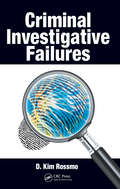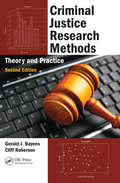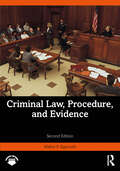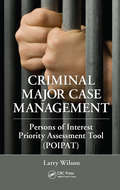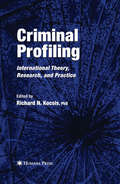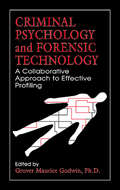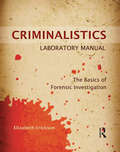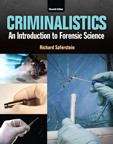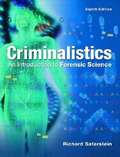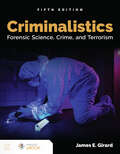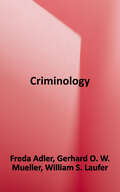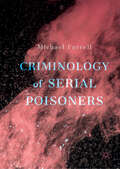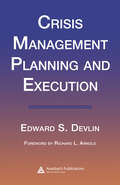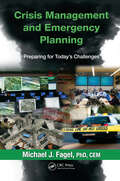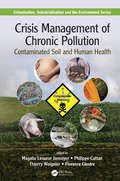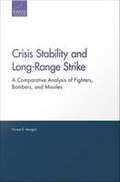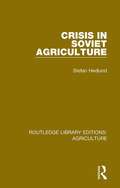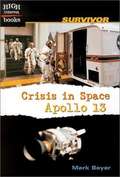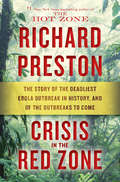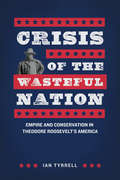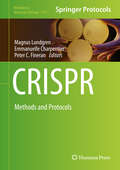- Table View
- List View
Criminal Investigation: The Art And The Science
by Michael LymanCriminal Investigation: The Art and the Science ― by nationally recognized criminal investigation expert Michael Lyman ― is a clear, thorough examination of the fundamentals of criminal investigation and forensic science, as currently practiced throughout the US. It explores past experiences of investigators alongside forensic and technological innovations. Paralleling the steps of the criminal investigation, the 9th edition has been extensively updated with new and revised material, a new chapter on investigating officer-involved shootings, and updated case studies and graphics.
Criminal Investigative Failures
by D. Kim RossmoAvoid Major Investigative TrapsWhat causes competent and dedicated investigators to make avoidable mistakes, jeopardizing the successful resolution of their cases? Authored by a 21-year police veteran and university research professor, Criminal Investigative Failures comprehensively defines and discusses the causes and problems most common to faile
Criminal Justice Research Methods: Theory and Practice, Second Edition
by Cliff Roberson Gerald J. BayensThe study of research methodologies can be daunting to many students due to complex terminology, mathematical formulas, and lack of practical examples. Now in its second edition, Criminal Justice Research Methods: Theory and Practice offers a straightforward, easy-to-understand text that clarifies this complex subject matter, keeping perplexing research language and associated complexities to a minimum and ensuring that students get a practical grasp of this essential topic.The authors discuss scientific inquiry, establishing a framework for thinking about and understanding the nature of research. They examine various types of research methods in the broad categories of quantitative, qualitative, and evaluation designs and provide coverage of analytical and experimental research designs. The book also examines survey methods, survey instruments, and questionnaires, including wording, organization, and pretesting. It describes the fundamental characteristics of the qualitative approach, setting the stage for an in-depth discussion of the participant observation and case study methods of research. Other topics include ethical standards of conduct, topic selection, literature review, and guidelines for writing a research report or grand proposal. The second edition features updated examples, reworked exercises, additional discussion points, and new research-in-action sections.Defining a clear approach to the study of research, the book enables student experiencing their initial exposure to this subject to be fundamentally prepared to be proficient researchers in criminal justice and criminology.
Criminal Law, Procedure, and Evidence
by Walter P. SignorelliProviding a complete view of U.S. legal principles, this book addresses distinct issues as well as the overlays and connections between them. It presents as a cohesive whole the interrelationships between constitutional principles, statutory criminal laws, procedural law, and common-law evidentiary doctrines. This fully revised and updated new edition also includes discussion questions and hypothetical scenarios to check learning. Constitutional principles are the foundation upon which substantive criminal law, criminal procedure law, and evidence laws rely. The concepts of due process, legality, specificity, notice, equality, and fairness are intrinsic to these three disciplines, and a firm understanding of their implications is necessary for a thorough comprehension of the topic. This book examines the tensions produced by balancing the ideals of individual liberty embodied in the Constitution against society’s need to enforce criminal laws as a means of achieving social control, order, and safety. Relying on his first-hand experience as a law enforcement official and criminal defense attorney, the author presents issues that highlight the difficulties in applying constitutional principles to specific criminal justice situations. Each chapter of the text contains a realistic problem in the form of a fact pattern that focuses on one or more classic criminal justice issues to which readers can relate. These problems are presented from the points of view of citizens caught up in a police investigation and of police officers attempting to enforce the law within the framework of constitutional protections. This book is ideal for courses in criminal law and procedure that seek to focus on the philosophical underpinnings of the system.
Criminal Major Case Management: Persons of Interest Priority Assessment Tool (POIPAT)
by Larry WilsonIn high-profile investigations, when the suspect pool is very large, resources are unduly strained unless the pool can be narrowed down to the most likely offenders. The Persons of Interest Priority Assessment Tool (POIPAT) provides an objective and consistent means of establishing a priority ranking of suspects or persons of interest in any invest
Criminal Profiling: International Theory, Research, and Practice
by Richard N. KocsisIn this book, renowned profiler Dr. Richard Kocsis presents a distinct approach to profiling called Crime Action Profiling or CAP. The volume explains the scope and methodology employed in the studies that the author has undertaken over the past decade and a half. CAP adopts the view that profiling essentially represents a psychological technique that has its foundations in the disciplinary knowledge of forensic psychology.
Criminal Psychology and Forensic Technology: A Collaborative Approach to Effective Profiling
by Grover Maurice GodwinOffender profiling has been developing slowly as a possible investigative tool since 1841 and the publication of Edgar Allen Poe's The Murder in the Rue Morgue. In this book, detective C. Auguste Dupin demonstrates the ability to follow the thought patterns of a companion while they stroll through Paris for 15 minutes without speaking a word. Today
Criminalistics Laboratory Manual: The Basics of Forensic Investigation
by Elizabeth EricksonThe Criminalistics Laboratory Manual: The Basics of Forensic Investigation provides students with little to no prior knowledge of forensic science with a practical crime scene processing experience. The manual starts with an original crime scene narrative setting up the crime students are to solve. This narrative is picked up in each of the forensic science lab activities, tying each forensic discipline together to show the integrated workings of a real crime lab. After the completion of all of the exercises, the student will be able to solve the homicide based on forensic evidence.
Criminalistics: An Introduction to Forensic Science
by Richard SafersteinThis best-selling text, written for the non-scientist, is appropriate for a wide variety of students, including criminal justice, law enforcement, law, and more! Criminalistics: An Introduction to Forensic Science, 11e, strives to make the technology of the modern crime laboratory clear and comprehensible to the non-scientist. The nature of physical evidence is defined, and the limitations that technology and current knowledge impose on its individualization and characterization are examined. By combining case stories with applicable technology, Criminalistics endeavors to capture the pulse and fervor of forensic science investigations. A major portion of the text centers on discussions of the common items of physical evidence encountered at crime scenes. These chapters include descriptions of forensic analysis, as well as updated techniques for the proper collection and preservation of evidence at crime scenes. Particular attention is paid to the meaning and role of probability in interpreting the evidential significance of scientifically evaluated evidence.
Criminalistics: An Introduction to Forensic Science (8th Edition, College Version)
by Richard SafersteinThe text covers the comprehensive realm of forensics and its role in criminal investigations. Physical evidence collection and preservation techniques are examined in detail including chapters on Computer Forensics and DNA.
Criminalistics: An Introduction to Forensic Science (8th Edition, High School Version)
by Richard SafersteinIn this new edition of Criminalistics, the noted forensic scientist Richard Saferstein brings the reader into the crime lab for a firsthand look at the role of science in the criminal justice system. Criminalistics focuses its attention on the up-to-date technologies police rely on to apprehend criminal perpetrators and to link them through trace evidence to crime scenes. This new edition emphasizes the latest DNA profiling technologies, which include STR and mitochondrial DNA. The book details how the creation of a new nationwide DNA data bank has been designed to apprehend the mobile criminal. Today, the ability to detect less than one-billionth of a gram of DNA means that forensic scientists can extract critical information at crime scenes from stamps and envelopes licked with saliva, a cup or can that has come in contact with a person's lips, chewing gum, the sweat band of a hat, or a bed sheet containing an individual's skin cells.
Criminalistics: Forensic Science, Crime, and Terrorism
by James E. GirardCriminalistics continues to set the standard for modern forensic methods and investigative techniques in a new, updated fifth edition. Beginning at the crime scene and proceeding to the forensic laboratory, the text walks the reader through the entire forensic investigation. Students learn how to accurately identify, gather, and analyze multiple types of evidence by examining actual crimes that were solved using the techniques presented. The Fifth Edition features new contemporary case studies and updated statistics. Also, the section about terrorism has been updated and expanded to include important terrorism-related topics: agroterrorism, the forensic analysis of internet data, cyberterrorism, explosives, weapons of mass destruction, and the techniques used to identify them. The most comprehensive and accessible text of its kind, Criminalistics: Forensic Science, Crime, and Terrorism, Fifth Edition is a practical, student-friendly introduction to this exciting science.
Criminology
by Freda Adler Gerhard O. W. Mueller William S. LauferCriminology is a young discipline. In fact, the term "criminology" is only a little more than a century old. But in this brief time, criminology has emerged as an important social and behavioral science devoted to the study of crime and criminal behavior, and the society's response to both. <p><p>Criminology fosters theoretical debates, contributes ideas and constructs, develops and explores new research methodologies, and suggests policies and solutions to a wide range of crime problems that dramatically affect the lives of countless people in the United States and around the world. Problems as vital and urgent as those addressed in this book are challenging, exciting, and, at the same time, disturbing and tragic. Moreover, these problems are immediately relevant to all of our lives. This is especially true today, when crimes here and abroad touch so many lives, in so many ways. <p><p>Our goal with this book has been, and remains, to discuss these problems, their origins, and their possible solutions in a clear, practical, straightforward fashion that brings the material to life for students. We invite faculty and students alike to join the authors' in traveling along criminology's path, exploring its expanding boundaries, and mapping out its future.
Criminology of Serial Poisoners
by Michael FarrellThis book examines serial homicidal poisonings in the modern era, to improve our contemporary understanding of poisons, poisoners, and investigation. Drawing on cases of serial poisoning from around the world, the book defines key terms, examines theories and explanations of serial homicide in relation to serial poisoning, explores the features of the poisons and examines the demographic characteristics of perpetrators of serial poisoning and their victims. It considers healthcare serial poisoning as a specific issue. Overall, it provides an outline for developing a criminology of serial poisoning homicide.
Crisis Averted: The Hidden Science of Fighting Outbreaks
by Caitlin Rivers&“[An] ambitious and... successful attempt to reset our relationship with the field of public health. With a judicious blend of candor, hopefulness and pragmatism, [Rivers] calls out its mistakes, reminds us of its historic accomplishments and emphasizes the need for the discipline to adjust its strategies if its full promise is to be realized.&”—Wall Street Journal"A master class in how we can pinpoint and prevent health crises before they spiral out of control."—Scott Gottlieb, MD, author of Uncontrolled SpreadA fascinating window into the secret life of epidemiology, weaving together stories of triumph and tragedy, with a boots-on-the-ground perspective on how we can avert the next public health crisisThere are few visible markers of the accomplishments of public health. When epidemiologists do their jobs, nothing happens. An outbreak does not grow into an epidemic. A child does not go hungry. A would-be smoker never lights up. In this fascinating window into the secret life of public health, Caitlin Rivers weaves together stories of triumph and tragedy to show that by making sure things don't happen, she and legions of scientists, practitioners, and policymakers change the course of history.We have many of the tools and experiences needed to prevent the next crisis, but as past experiences teach us, the unexpected is always around the corner. We cannot afford complacency, as countless challenges remain, including constantly emerging pathogens, the rapid growth of biotechnology, and the inconsistent cycles of funding for public health programs. Progress can be slow, but the unsung heroes in epidemiology remain focused on their missions. Crisis Averted tells their stories—from the eradication of smallpox in the twentieth century to a battle against mosquito-borne diseases in the Florida Keys to the international safeguards implemented against extraterrestrial germs. By taking a candid look at how we solve problems in public health, Caitlin Rivers illuminates the role of epidemiology in all our lives and lays out the case for what can be accomplished given sufficient vision, leadership, and resources. Crisis Averted is an inspiring and galvanizing call for us to work together towards a healthier, more resilient future.
Crisis Management Planning and Execution
by Edward S. DevlinCrisis management planning refers to the methodology used by executives to respond to and manage a crisis and is an integral part of a business resumption plan. Crisis Management Planning and Execution explores in detail the concepts of crisis management planning, which involves a number of crises other than physical disaster.Defining th
Crisis Management and Emergency Planning: Preparing for Today's Challenges
by Michael J. FagelEmergency managers and officials have seen a tremendous increase in the planning responsibilities placed on their shoulders over the last decade. Crisis Management and Emergency Planning: Preparing for Today's Challenges supplies time-tested insights to help communities and organizations become better prepared to cope with natural and manmade disas
Crisis Management of Chronic Pollution: Contaminated Soil and Human Health (Urbanization, Industrialization, and the Environment #1)
by Magalie Lesueur Jannoyer Philippe Cattan Thierry Woignier Florence ClostreCrisis Management of Chronic Pollution: Contaminated Soil and Human Health deals with a long term pollution problem, generated by the former use of organochlorine pesticides. Through a case study of the chlordecone pollution in the French West Indies, the authors illustrate a global and systemic mobilization of research institutions and public services. This "management model", together with its major results, the approach and lessons to be learned, could be useful to other situations. This book gathers all the works that have been carried out over the last ten years or more and links them to decision makers’ actions and stakeholders’ expectations. This reference fills a gap in the literature on chronic pollution.
Crisis Stability and Long-Range Strike: A Comparative Analysis of Fighters, Bombers, and Missiles
by Forrest E. MorganTo effectively manage an international crisis, the United States must balance its threats with restraint. It must posture forces in ways that deter aggression without implying that an attack is imminent, while limiting its own vulnerability to surprise attack. A RAND study sought to identify which long-range strike assetsâ#128;#148;strike fighters, bombers, ballistic missiles, cruise missilesâ#128;#148;offer capabilities most conducive to stabilizing such crises.
Crisis in Soviet Agriculture (Routledge Library Editions: Agriculture #8)
by Stefan HedlundThis book, first published in 1984, analyses the institutions and decision-making processes that determined agricultural production in the Soviet Union. It addresses the crisis in Soviet agriculture of the early 1980s, examining the problems of low productivity, adverse natural conditions and an underdeveloped infrastructure. The book’s analysis of the ‘crisis’ focuses on the growing gap between demand and supply of agricultural produce, and the pressures on the government to alleviate the food shortages.
Crisis in Space: Apollo 13
by Mark BeyerThe book recounts the events related to the ill-fated Apollo 13 mission and how the crew and mission control handled the inflight crisis.
Crisis in the Red Zone: The Story of the Deadliest Ebola Outbreak in History, and of the Outbreaks to Come
by Richard PrestonThe 2013–2014 Ebola epidemic was the deadliest ever—but the outbreaks continue. Now comes a gripping account of the doctors and scientists fighting to protect us, an urgent wake-up call about the future of emerging viruses—from the #1 bestselling author of The Hot Zone, now a National Geographic original miniseries. <P><P> This time, Ebola started with a two-year-old child who likely had contact with a wild creature and whose entire family quickly fell ill and died. The ensuing global drama activated health professionals in North America, Europe, and Africa in a desperate race against time to contain the viral wildfire. <P><P>By the end—as the virus mutated into its deadliest form, and spread farther and faster than ever before—30,000 people would be infected, and the dead would be spread across eight countries on three continents. In this taut and suspenseful medical drama, Richard Preston deeply chronicles the outbreak, in which we saw for the first time the specter of Ebola jumping continents, crossing the Atlantic, and infecting people in America. <P><P> Rich in characters and conflict—physical, emotional, and ethical—Crisis in the Red Zone is an immersion in one of the great public health calamities of our time. Preston writes of doctors and nurses in the field putting their own lives on the line, of government bureaucrats and NGO administrators moving, often fitfully, to try to contain the outbreak, and of pharmaceutical companies racing to develop drugs to combat the virus. He also explores the charged ethical dilemma over who should and did receive the rare doses of an experimental treatment when they became available at the peak of the disaster. <P><P> Crisis in the Red Zone makes clear that the outbreak of 2013–2014 is a harbinger of further, more severe outbreaks, and of emerging viruses heretofore unimagined—in any country, on any continent. In our ever more interconnected world, with roads and towns cut deep into the jungles of equatorial Africa, viruses both familiar and undiscovered are being unleashed into more densely populated areas than ever before. <P><P>The more we discover about the virosphere, the more we realize its deadly potential. Crisis in the Red Zone is an exquisitely timely book, a stark warning of viral outbreaks to come. <P><P><b> A New York Times Bestseller</b>
Crisis of the Wasteful Nation
by Ian TyrrellLong before people were "going green" and toting reusable bags, the Progressive generation of the early 1900s was calling for the conservation of resources, sustainable foresting practices, and restrictions on hunting. Industrial commodities such as wood, water, soil, coal, and oil, as well as improvements in human health and the protection of "nature" in an aesthetic sense, were collectively seen for the first time as central to the country's economic well-being, moral integrity, and international power. One of the key drivers in the rise of the conservation movement was Theodore Roosevelt, who, even as he slaughtered animals as a hunter, fought to protect the country's natural resources. In Crisis of the Wasteful Nation, Ian Tyrrell gives us a cohesive picture of Roosevelt's engagement with the natural world along with a compelling portrait of how Americans used, wasted, and worried about natural resources in a time of burgeoning empire. Countering traditional narratives that cast conservation as a purely domestic issue, Tyrrell shows that the movement had global significance, playing a key role in domestic security and in defining American interests around the world. Tyrrell goes beyond Roosevelt to encompass other conservation advocates and policy makers, particularly those engaged with shaping the nation's economic and social policies--policies built on an understanding of the importance of crucial natural resources. Crisis of the Wasteful Nation is a sweeping transnational work that blends environmental, economic, and imperial history into a cohesive tale of America's fraught relationships with raw materials, other countries, and the animal kingdom.
Crisis on the Coast and Hinterland: Assessing India’s East Coast with Geomorphological, Environmental and Remote Sensing and GIS Approaches
by Ashis Kumar Paul Anurupa PaulThis contributed volume assesses the state and future of India’s East Coast through a wide variety of chapters grouped by methodology and approach. Part I: Assessment through Geomorphological Approaches describes geomorphological diversities of the eastern shorelines of India, Coastal Modelling System- SMC and morphodynamics of Odisha coast, Paleo shorelines and beach ridge chenier formations of Subarnarekha delta, seasonal sediment budget of Chandrabhaga beachdune system, Beach stage and dune stage modelling Mandarmoni coast, drainage characters of South Andaman Islands, coastal foredune morphology and sediment of Odisha and West Bengal, Geo-archaeological pieces of evidence of ancient coastal environment, coastal sediment characters, beach ridge formation in the chenier coast, and geomorphological changes of ancient ports and harbours in the shoreline of West Bengal. Part II: Assessment through Environmental Approaches addresses various environmental assessment techniques of mangrove sensitivity to the sea level rise process in the Sundarban, land degradation of the hinterland drainage basins, the riparian environment of the coastal drainage basins, agricultural adaptability in response to climate variability in the coastal areas of West Bengal, forest degradations of the lateritic upland tracts, coastal tourism potentialities in Odisha and West Bengal, Climate variabilities and agricultural modifications in the hinterland areas of West Bengal districts, the tidal flat environment of Sagar Island, landforms and Geomorphosites for the promotion of Geotourism in South Andaman Perils of Premature Reclamation of Sundarban, marine litter in the coastal regions of West Bengal and Odisha on flora, fauna and humans, Ground water contamination due to saline water encroachment in coastal Andhra Pradesh and Spatio-temporal changes in the Hugli estuarine environment and coastal hazards and flood risk of southwestern Sundarban. Part III: Assessment through Remote Sensing & GIS Approaches uses the aforementioned techniques in service of exploration of monitoring health of Mangrove forest, Geomorphological analysis of the coral fringed coasts of Andaman, hydrological and morphological variations of Ichhamati Tidal estuary, multivariate analysis of coastal vulnerabilities, geography of tourism resources in Andaman group of islands, tourism climate index with application geospatial techniques, diversity of landscape ecology in the coastal blocks of Purba Medinipur, overwash vulnerability in Odisha coast, livelihood security index of the coastal communities, managing coastal squeeze response and wetland loss in the estuarine coastal tract of West Bengal, environmental effects of historical land reclamation process in the Sundarban, and emerging environmental problems of coastal urbanization in Digha, Kanthi, and Haldia.
Crispr: Methods and Protocols (Methods in Molecular Biology #1311)
by Magnus Lundgren Emmanuelle Charpentier Peter C. FineranThis volume presents a list of cutting-edge protocols for the study of CRISPR-Cas defense systems and their applications at the genomic, genetic, biochemical and structural levels. CRISPR: Methods and Protocols guides readers through techniques that have been developed specifically for the analysis of CRISPR-Cas and techniques adapted from standard protocols of DNA, RNA and protein biology. Written in the highly successful Methods in Molecular Biology series format, chapters include introductions to their respective topics, lists of the necessary materials and reagents, step-by-step, readily reproducible laboratory protocols, and tips on troubleshooting and avoiding known pitfalls. Authoritative and cutting-edge, CRISPR: Methods and Protocols provides a broad list of tools and techniques to study the interdisciplinary aspects of the prokaryotic CRISPR-Cas defense systems.

